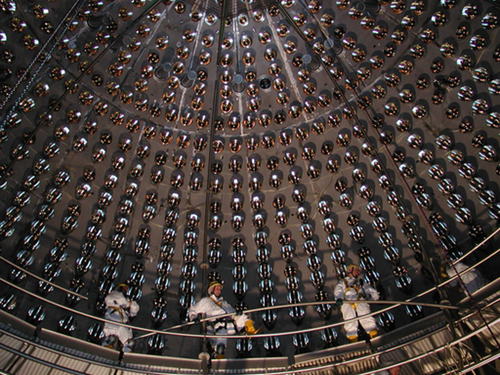Neutrinos Detected from the Earth’s Mantle
The steady decay of long-lived radioactive isotopes within the Earth heats the planet and also sends out streams of neutrinos, which can be observed by large detectors. The Borexino Collaboration now reports a new set of data for such “geoneutrinos” and indicates that at least some of them originate from the Earth’s mantle. The work could improve researchers’ understanding of how radioactive decays help drive internal geophysical processes, including the slow convection of rock in the Earth’s mantle.
Neutrinos are notorious for interacting with matter extremely rarely—a light-year-thick wall of lead would only stop half of the neutrinos flying through—so detection is challenging. But using large detectors, both Borexino and KamLAND, another international collaboration, have previously detected geoneutrinos with very high confidence. With more data, researchers hope to gain further information about the distribution of radioactive isotopes in the Earth’s interior and about the amount of heat they deliver to various subterranean regions.
The Borexino detector, which contains 300 metric tons of a fluid that can emit light flashes in response to particles, operates at the underground Gran Sasso National Laboratory in Italy and detects electron antineutrinos, commonly created in nuclear decays. From December of 2007 through March of 2015, the detector recorded a total of 77 candidate geoneutrino events, compared with 46 events the team reported in 2013 [1].
Of all known long-lived radioactive isotopes, only uranium-238 and thorium-232 are abundant enough and produce antineutrinos of sufficient energy to contribute significantly to detection events. However, nuclear reactors also generate antineutrinos. Using data from the International Atomic Energy Agency, the Borexino team calculated that about 53 of the 77 detected antineutrinos were likely to be from reactors, leaving about 24 true geoneutrinos. The certainty of this detection is the highest ever achieved for geoneutrinos; the chance that all of these particles come from reactors is less than one in a hundred million.
The Borexino collaboration estimated the number of geoneutrinos originating from the Earth’s mantle, rather than from the crust. Their previous estimate had a large uncertainty and not very high confidence that any of the detected geoneutrinos came from the mantle. With the larger dataset, the team reduced the error bars enough to say that there is only a 2% probability that all of the neutrinos came from the crust. To find the fraction from the mantle, as before, they estimated the number of neutrinos expected from the crust based on the measured abundance of uranium and thorium and then subtracted this number from the total. They found that about half of the geoneutrinos most likely originated from the mantle.
The researchers also estimated the total amount of heat generated by radioactive decays. Geoscientists know that the Earth generates about 47 terawatts of power from its interior, some from “primordial heat” left over from the Earth’s formation and the rest from radioactive decays. The fraction of heat attributable to each of these sources remains largely unknown. The new Borexino analysis gives an estimate for the radiogenic component of heating of about 33 terawatts (with large error bars)—higher than earlier studies.
Borexino team leader Aldo Ianni, of the Gran Sasso Laboratory, suggests that future studies conducted over longer periods of time will reduce uncertainties and allow accurate geoneutrino spectroscopy—distinguishing neutrinos according to the element from which they originated. Such data would provide information on the distribution of isotopes throughout the Earth’s interior. The current study could just barely distinguish between antineutrinos coming from uranium-238 decays and those from thorium-232 decays, based on the particles’ energies. However, the uncertainties remain too large to make definitive statements.
“For those of us in the field, this is very impressive progress,” says Jason Detwiler of the University of Washington in Seattle, a member of the KamLAND group. “Their spectrum is very clean and beautifully and incontrovertibly demonstrates the presence of the geoneutrino signal.” Detwiler says that the number of mantle neutrinos seen by Borexino may have geophysical significance. ”The data are consistent with there being enough radiogenic heat to drive mantle convection,” he says, referring to the slow turnover of mantle material over geologic time.
This research is published in Physical Review D.
Correction (14 August 2015): We revised the statement about the probability of neutrinos originating entirely from the crust to more accurately reflect the Borexino team's probability analysis.
–Mark Buchanan
Mark Buchanan is a freelance science writer who splits his time between Abergavenny, UK, and Notre Dame de Courson, France.
References
- G. Bellini et al. (Borexino Collaboration), Phys. Lett. B 722, 295 (2013).





